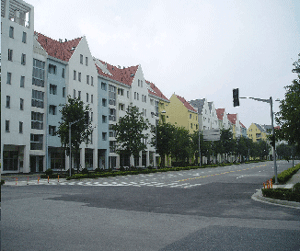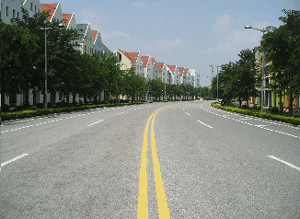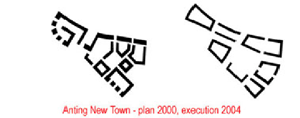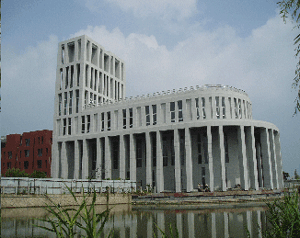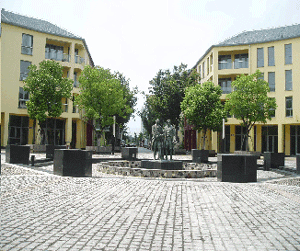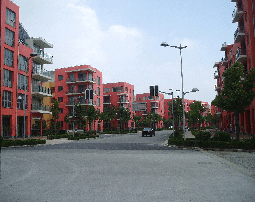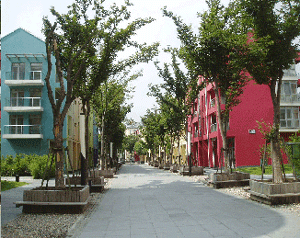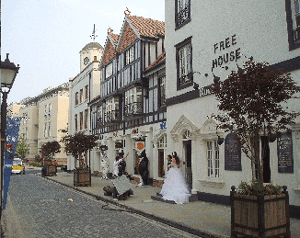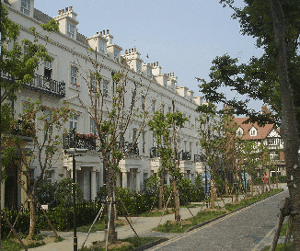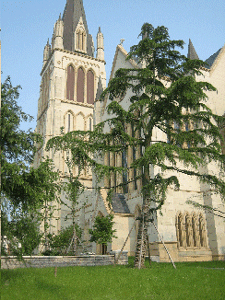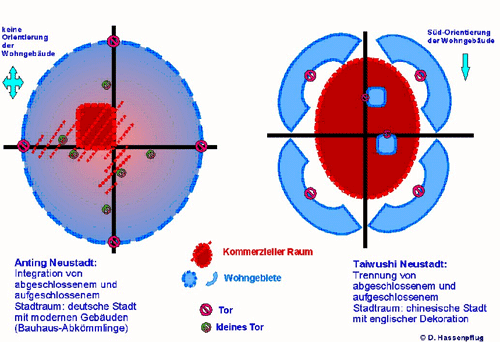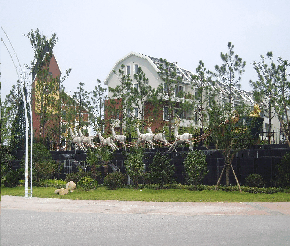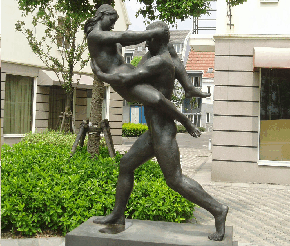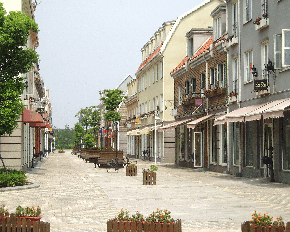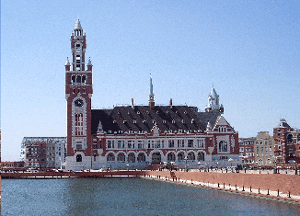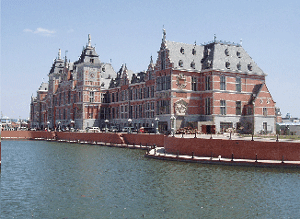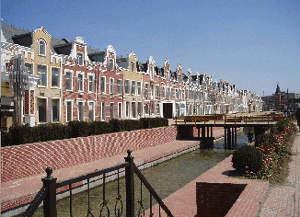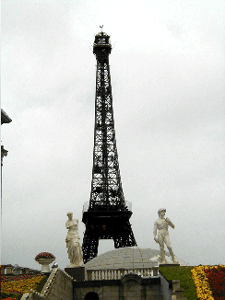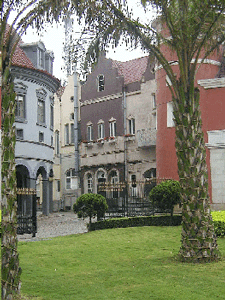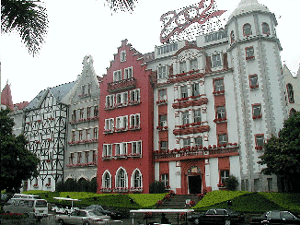The following contribution, being based on chapter 6 of a study about the urban code of China (Hassenpflug 2008), provides an analysis of the results of the transposition of European urban structures and images into Chinese urban space. Four theme cities, thereof three from the Shanghai “One City, Nine Towns-Plan” and one from Liaoning-Province capital city Shenyang have been chosen for case studies. In addition the urban fakes of a theme park located in Shenzhen (Guangdong-Province) have been taken into consideration.
The method that has been applied for this analysis we call “urban semiology”. Urban semiology recognizes the spatial elements of a city (referent) as signifiers which refer to something signified, i.e. to a meaning or content (Peirce 1991). Regarding urban space as a socio-cultural text and urban elements as signs this heuristics allows us to read and interpret the city. It is based on the assumption that people produce spaces for living, and while doing this they materialize their wishes, hopes, struggles, losses and victories. In this way their habitats take shape as urban texts which inform about the life, the ideas and conflicts of its planners, architects and diverse users. The more urban semiology enables us to identify and to assess different urban codes which meet, mix, complement or reject each other in the course of the urban transposition from Europe to China.
“Urban semiology” differs from “social semiology” (Gottdiener 1986) primarily with regard to its recourse towards historical and cultural facts. In this respect urban semiology stands closer to approaches of cultural geography than to those of urban sociology. Sociological spatial heuristics primarily focus on reading urban spaces as narratives that inform about spatialized social actions, negotiations, struggles, strategies and related beliefs, ideologies, utopias, or visions. Urban semiology in contrast aims at “remembering the new” to put it in the words of Walter Benjamin, i.e. at deciphering the deeply rooted stock of cultural conventions, patterns, traces that forms a dimension of built urban space at any time (Benjamin 1991, I 493, II 1024). In this perspective new urban space, each new settlement or new town, contains hidden socio-cultural messages that can be mined by a method he called “superposition” (Benjamin 1991, I 526 ; Hassenpflug 2001). Superposition has to be taken as a tool of reminding, thus of urban semiology.
In his architectural semiology Umberto Eco discusses about iconic messages that are transmitted by spatial facts (Eco 1972/1994). Related to this he distinguishes denotative and connotative messages. Denoted are primary or essential functions while secondary or inferior functions are connoted. To give an example : Like every house or flat a generously and spaciously designed villa denotes “home”, “secure place” or “privacy”. Depending on the associations of the observing individual the villa connotes “richness”, “affluence”, “high social status”, and etc. Denotations are objective. Given unbiased they restrict the scope of interpretations of the individual who receives the messages. In contrast those interpretations or contents are connoted that have been projected onto the signifier (the villa). Connotations are nominal, i.e. changing, volatile, cursory, or passing views or meanings.
If a house has a courtyard (e.g. a tíng yuàn which can be compared with a Roman peristyl) but no decorated façade it transmits quite different messages than a house with a decorated façade facing open public space. The first example (courtyard house) which refers to the Chinese sìhéyuàn denotes conclusively the priority of family and community. The latter example, i.e. the house with extroverted decorated façade indicates the space production of a likely individualized bourgeois society.
Gates, barriers, walls and fences which easily can be detected in the extensively bolted Chinese cities are signifying closed units, especially of gated neighbourhoods which are called “compounds” in the true sense of the word. As much as the compounds hand down the tradition of introversion by exposing “neighbourhood courtyards” they denote the precedence of family, community or collective. In contrast an extroverted square (piazza or market place) that is framed by decorated gable façades, thus staging the square theatrically, denotes the presence and ambitions of a more individualized society, i.e. of “civil society” or “association” unlike “community”, to put it in the words of Tönnies (Tönnies 2001)
It depends on which form of social nexus has priority in a cultural context whether produced space appears more introverted or more extroverted. In present China the traditional powers of community, collective or rural life are more and more penetrated by the modern powers of society (association), individualism and urban life all being continuously released since Chinas opening by the rapidly expanding capitalistic market economy. The share of community (rural life) and civil society (urban life) reveals itself in the prevailing Chinese urban design : The priority of community over association (civil society) produces cities that appear like cellular landscapes of urbanized villages. Each compound is an urban village.
The only spaces that are truly open in Chinese cities since long time are commercial spaces. Except from some newly developed public places like squares, greens and parks only commercial activities keep urban space open until today. However, during the rule of Mao Ze Dong the open spaces for commercial use have been transferred to gated semi-rural or semi-urban producers’ cooperatives called “danwei”. Since the opening of China and the rapid development of its market economy the dualism of opened and enclosed space becomes crucial. Today the entire orchestration of the Chinese city submits to this “binary code” of open and close space.
The socio-culturally biased urban semiology informs us for example about the great significance of north-orientation of houses and flats in China. The European tradition of parcelled block border construction reflects low emphasis on orientation. Here the claim for orientation has to be regarded as an achievement of the hygienic movement of the 19th and the early 20th century, being codified by the Charta of Athens (1933). However, in China orientation is not only related to climate but also to social status. In old courtyard house settlements like the hutong in Beijing the parents or oldest family members held the privilege to live in the south oriented main building. Today the former senior’s privilege has been transformed into a middle class privilege. For status reasons or rather collecting distinction gains the houses or flats of this rapidly growing social stratum have to be oriented to the south in most parts of China. If not it gets very difficult to sell them.
The new Satellite Cities in Shanghai.
Towards the end of the millennium the city government, under the impression of permanent population increase in the core districts of the mega-metropolis Shanghai with its 18 million inhabitants, employed a method of relieving urban growth that could be called ‘classic’ : the creation of satellite cities. As result, the new strategic development concept for the city, titled ‘One City, Nine Towns’, was agreed upon within the context of the 10th Five-Year-Plan (2001 ― 2005). It was expanded as ‘1966-Plan’ within the 11th Five-Year-Plan (2006 ― 2010). The construction of the city of Songjiang (the singular city) and 9 smaller cities (‘towns’) with a projected number of 5.4 million inhabitants is intended to cause the decrease of the inner city population (approximately 8 million inhabitants) by approximately 1.1 million inhabitants (according to the numbers of 2000) until 2020.
Beyond that, these plans are supposed to enable a controlled development of the city. The keyword here is ‘polycentric growth’ : The ten new cities (1+9) are intended to be ‘self-sufficient’ or functionally integrated, meaning that they must provide an adequate number of local jobs, public infrastructure (kindergartens, schools, health care institutions, etc.), retail and small businesses, etc. This is intended to reduce the overwhelming commuter traffic between urban core and periphery. Polycentricity is further supposed to secure remaining agricultural land, reduce sprawl, promote the creation of green spaces and especially concentrate traffic and control it more efficiently. Thus, a large-scale traffic development plan is an integral part of the ‘One City, Nine Towns-Plan’. Beyond that, within EXPO 2010, Shanghai, which has adopted this plan in the meantime, underscores the relevance of satellite cities both within and beyond the urban fringe [1] for the dynamic change of demands regarding lifestyle and space within the growing middle class of China. [2]
This plan can thus be described as ‘classic’ since it recurs to models and practices of satellite city plans from the era of large-scale urban development in Europe and North America. In this context, already the construction of philanthropic workers settlements in Great Britain, France, and Germany [3], although also the Garden City movement of the late 19th and early 20th century [4], and the so-called New Town movement in the 1960’s beginning in Great Britain and France (Milton Keynes, …) are worth mentioning.
One must also include ‘New Urbanism’, originating in North America, as a reference model of urban planning and design (Ziegler 2006). Not only because it is explicitly mentioned within the context of the ‘One City, Nine Towns Plan’ of the city of Shanghai, but also because it is highly important for the subject of ‘citytainment’ in China. After all, the historicist New Urbanism refers to a paradigm change within the understanding of urban development that can be summed up in the following sentence : Away from the faceless functionalism of classic modernism onwards to a ‘reflexive modernism’ (Hassenpflug 2006) in which tradition and modernism can rejoice. But this also means : Away from the fostering of centrifugal forces of urban development, and onwards to supporting and creating centripetal dynamics ! The idea behind New Urbanism however is not satellite city planning for growing cities, but, on the opposite, an antagonism to ‘urban sprawl’, a return to the city, to density, to public space, to centricity. It is thus opposed to what has essentially been created in the name of early industrial and Fordist satellite city planning.
In this regard, the emergence of ‘New Urbanism’ within the context of the Shanghai satellite city plan cannot be explained in simple terms. In China, we can find neither urban sprawl comparable to North America, nor a narrative such as that of the ‘common man’ and the ‘frontier’ (Hardinghaus 2004) that could be interpreted as supporting this kind of migration to suburbs. But why, however, does New Urbanism still play a role ? For the time being, two brief explanations will have to suffice.
A first explanation is offered by the unusually ambitioned expectations of almost experimental character connected to the ‘One City, Nine Towns-Plan’. The satellite cities are not only intended to demonstrate technically advanced construction methods in the areas of ecological soundness, sustainability, energy efficiency, use of materials, etc. but also demonstrate concepts of urban aesthetics connected to predominantly western lifestyles. One kind of interpretation of this demand is the pictorial representation of the culturally ‘typical’ (‘typical’ American, German, Italian, Nordic, etc.) within the medium of urban planning and design.
The second explanation leads us to the phenomenon of the rapid emergence of a strong and, of course heterogenic, Chinese middle class and the accompanying change of functional and aesthetic demands towards residential space. Reflecting upon the own Chinese history is still biased to a certain degree due to the traumas of the more recent history. Thus, the gaze is all the more liberated and outward bound in the open China of today and absorbs schematics and fashions of urban aesthetics, especially of the Western middle class and preferably of the United States of America. “The selling point of Chinese new (sub-) urbanism is a ‘new way of (good) life’, distinguishing itself from the outdated socialist utopianism.” The developers, according to Wu in his informative essay on ‘branding’ of the new Chinese neighbourhood unit, “are becoming ‘community builders’ like their North American counterparts and attempting to capture the imagination of the upwardly-mobile middle class. Through the imagination of simulated landscapes, often copied from foreign places, the developers are shaping a new myth of Chinese suburbia. The gate, especially built into spectacular and iconic styles, serves a visual anchor in the imagination of (sub-) urbanism.” (Wu, Fulong 2006)
China, according to the message of the ‘One City, Nine Towns-Plan’ with its theme cities, is still searching for itself ― and Shanghai envisions itself as the head of the Chinese dragon, surveying the world form above, obliged to stride forward and discover new directions.
Ten theme cities in ten districts have been projected, intended for development as artificial ‘in-vitro’-cities according to the guidelines of master plans as result of both contracts and competitions and characterized by ‘total’ planning in the vein of plan economy (and, thus, the exact opposite of incremental urban planning). According to my research these currently include the following projects :

Tab. 1 : Songjiang-New City (Taiwushi) and the satellite cities according to the ‘One City, Nine Towns-Plan’. © D. Hassenpflug
For a number of years now, the ‘One City, Nine Towns-Plan’ is being implemented ― mostly with government funding, since private investors are only marginally enthusiastic about these kinds of model projects. As changes continuously occur during implementation, the results are no longer consistent with the original planning [5]. In addition to this, the number of planned satellite cities obviously has gone far beyond the number of ten. Also, remaining historic villages, towns and small cities within the periphery of Shanghai receive increasing attention. Their potential as tourist sites is being discovered ― and the attempt is made to secure these locations through large-scale restoration and revitalization plans. One of these ‘villages’ already appears within the ‘One City, Nine Towns-Plan’ (Zhujiajiao). For the above mentioned reasons, it is not that easy to find out which of the 9 satellite cities is actually currently included in the plan [6].
However, we can be sure that the three case studies are included. These are as follows : Anting (Jiading District), Taiwushi (‘Thames Town’ as part of the Songjiang New City in the Songjiang District) and Luodian (Baoshan District). All three of these projects have, from the beginning, been part of the ‘One City, Nine Towns-Plan’ of the city of Shanghai and have also been completed to a large degree.
Straight out of Germany : Anting New Town.
Anting New Town is a product of mimesis in urban planning and design ― and as such, one of its kind [7]. The project represents the ambitioned attempt to materialize the idea of the German city in China. Anting New Town is not a copy of an actual German city, such as for instance Rothenburg ob der Tauber, Ulm, Celle, Görlitz, or even the ‘sister city’ Weimar. It is also not an assemblage or a collage of copies of German building ensembles or singular buildings. Instead, Anting is intended to present the German city ‘as such’. Talking philosophically one would say : Within the medium of urban planning, urban design and architecture the German city is to be exemplified ; an ‘ideal type’, so to speak, is to be constructed in concrete, glass, asphalt and stone. À truly Herculean effort !
In a certain way, the Frankfurt-based architectural and planning firm AS&P created this task for and by itself, since it is the interpretation of a contract for the development of a ‘German city’ in the Province of Jiading. The clients themselves probably thought of a simple copy of a city, a piece of the historic city centre of Weimar including Frauenplan and Goethehaus, Schillerstrasse and Schillerhaus, Marktplatz and city hall, Anna Amalia library and Stadtschloss, etc. In other words, an assemblage or collage of urban building blocks placed on an open urban theatre stage, rimmed with enclosed neighbourhoods (‘gated communities’). Albert Speer and his partners however decided differently. Within their master plan, they sought for the combination of two concepts with high demands regarding quality :
For one, they decided for an ‘organic plan’ as a typified spatial structure of the medieval European city as basis. This appeared to be possible since the German city in its traditional layout shares this spatial grammar. Also, the medieval urban morphology is still characteristic for the urban core (important for both image and identity) of most German cities. In addition, Germany is to this day still characterized by being a landscape with small- and medium-sized cities ― a circumstance that becomes more apparent than usual when comparing the German cityscape with its Chinese counterpart with its many mega cities and their millions of inhabitants.
Also, they included the demands which high quality urban planning and design is subject to in Germany into their master plan. This particularly regards sustainable urban development, meaning for instance energy efficiency, quality of materials, emission reduction, waste separation, a balanced supply of green and recreational spaces, short walking distances, and not to forget, a rational design clearly based in the functionalist tradition of classic modernism.
Whereas the first principle affects mostly the basic structure of the projected city, the second principle influences the infill structure. Both basic structure and infill structure together create the image of the city. In the following, our attention is focused on the first principle. In order to proceed we shall recall the most important elements of the basic structure of the European city. These are as follows :
– the centre is defined Socio-culturally, meaning market place with church (as representative of ‘sacred’ urban space) and city hall (as representative of ‘civil’ urban space) define the spatially ‘inclusive’ public city centre
– the nodal centre is of mixed use
– small-scale block border construction based on lots and property ownership is dominant (orientation to south is of minor importance)
– streets and places create the ‘stage’ for public space by use of gable-end facades featuring decoration and ornamentation (extroversion)
– the spatial succession is structured hierarchically and the urban image is integrated into the context : while density decreases towards the centre, size and height of buildings increases, the building volumes of public buildings are oriented vertically (elevation of gable or eave)
– streets are non-linear or curved in the sense of an organic plan [8]
– city walls, moats, and fortifications are an iconic representation of a strict, not only spatial but also cultural distinction between interior and exterior (formerly between bourgeois city and feudal countryside)
A first glance at both the original models as also the part of the city that has been completed until today in the first (German) construction phase displays these characteristics more or less clearly : There is a central place with a church and larger buildings for public and commercial use. There is block border construction with vertically oriented buildings featuring pitched and hipped roofs, curved streets, gable end facades and a bordering by a kind of moat or trench. Also, the noticeably colourful character ― the buildings are painted in red, yellow, ochre, and blue hues ― cites the colourful character of the European city of times past.
Anting feels surprisingly open, walls and fences bordering residential areas do not exist.
Someone seems to have seriously attempted to emboss the idea of the German or European city into the earth of Jiading ― and this attempt has been, regarding the structures as mentioned above, successful, to a certain degree, in a certain sense, ‘in abstracto’.
On second glance however, the presented work indicates significant departures from the European rules, in fact, massive signs of dissolution. The intention to import the aroma of the German city by use of block border construction has suffered in a way that can be seen and felt ‑– an impression that is not minimized by the block border structures on site, but actually increased. By taking a look at the settlement one can recognize that a struggle for the actually indispensable block border has taken place and that compromises have been sought. Large parts of the city have been and are still in the process of being constructed as row and spot buildings or as solitary, serially arranged single family houses. Blocks are elongated, torn apart to a certain degree in their western or eastern periphery or can only be identified as fragments.
The streets are too broad and the buildings too modernist to provide the impression of visiting a historic city centre. Many buildings with pitched, hipped, and shed roofs are oriented with their eaves facing the street. Also, the few unadorned gable ends, reduced to pure functionality, are hardly capable of staging public urban space in an effective way. The curves of the streets feel aesthetically rather weak considering their width. In the end, the first completed construction phase of Anting New Town seems like a late Fordist residential development forced into the corset of a medieval basic structure. The result is slightly reminiscent of Kirchsteigfeld in Potsdam by Kohl and Krier, however much less historicist, rather a hybrid of old fashioned German and Bauhaus.
The strangest thing however is the way the entire urban space oscillates between seclusion and openness. Anting New Town presents itself as open urban space. Following the German tradition of urban planning and design, walls, hedges, and fences were omitted. Only the moat surrounding the New Town can be interpreted as a barrier in the sense of the closed city. But is this degree of openness possible in China ? Not to forget, residential buildings comprise the majority of built structures in the city ! Of course it isn’t possible ! So, the residential quarters needed to be closed, somehow. As result, small red guard houses ― of course with security personnel ― have been set up at driveways and junctions to side streets. But where does open urban space remain, belonging to that which is closed just as the key belongs to the lock ?
What happened ? Why does the transposed structure lack graphic quality so much ? Why isn’t there even a faint impression of the character of German town centres in Anting ? Is this due to the fact that Albert Speer actually intended to build a modern German town, a city that he would design that way in Germany (if someone could still build cities like that in Germany) ? Or is this just due to the fact that the plan, even though paying reverence to an archaic basic structure, has been covered with a modern infill structure ? Has Anting New Town, as a German small town, fallen victim to the Shanghai building code ? Or is Anting simply still too new, not vivid enough, has simply not been appropriated enough by its inhabitants ?
The displeasing result of the ‘transposition’ (Cai/Bo 2004, 45 ff.) of the idea of the German city raises many questions ― and provokes many answers. The key for these is however not based as much in the intentions of the German planners and architects and, one should add, their Chinese information sources. It is primarily based in the Chinese culture of appropriation, production, and consumption of space. Three key words are of importance here : Orientation, Exclusion, and Introversion.
Orientation.
The southern orientation was known and has been incorporated in the transposition of the idea of the German city to China. However, its meaning has been underestimated. Only during the course of developing the project the significance of this aspect became obvious to the planning actors, which in part led to drastic adjustments. The Shanghai planning and building code may have played a role here. In compliance to obviously deeply rooted daily cultural practices, variances are not permitted without special permission. The city finally conceded to permitting a variance covering 30% of the residential construction (Cai/Bo 2004, 74).
Buildings can only be placed along the block border without problems and can be used as the frame of or for staging the street space when there is a north-south orientation. An analysis of traditional and modern Chinese urban planning and design could have taught planners about how little leeway actually exists here ― and that other means were necessary to secure the enterprise of ‘transposition’. For instance, there is a certain degree of freedom in the placement of commercial or retail uses along the block border. À part of the retail spaces which have been built by now are placed however in buildings along an east-west axis, which indicates that the potential offered by commercial constructions for the creation of buildings along a north-south axis and thus closure of the block border had not been recognized.
In the light of this, it is not surprising that in the course of implementation someone had to hit the brakes. Blocks were pressed together and elongated in order to generate more southern oriented facades. In other cases, the eastern or western block periphery was simply omitted. These interventions transformed the closed block structure into two (Fordist) rows and the block courtyard into (Fordist) ‘separation green space’. Thus, in the course of a belated reactive creation of compromise, there was loss on one hand, the indispensable introversion, and gain on the other hand, southern orientation. However, it sounds slightly euphemistic if the creation of a new building typology, the ‘Anting Block’ (Dong/Ruff 2006) is evoked in this context. The illustration (figure 2) exemplifies the change from the original plan during the implementation process (Oldiges 2007).
Looking at the models of the second construction phase of Anting New Town, comprising more than 50% of the total area of the city, might trigger fear in the observer considering the large number of residential buildings oriented towards the west. The current stage of planning here may be the reason that a construction permit has not yet been issued for this construction phase. Is there still room for ideas for an improved orientation towards the south ? Hardly, since the ‘invisible city’ (infrastructure), involving a great deal of cost and work, and the network of streets has been completed already. The thus predetermined compact urban blocks offer too little space for rows along the block border oriented to the south. The only solution could be a distribution of vertically oriented nodal buildings across the building sites. However, this would completely destroy the impression of a German or European city.
Exclusion.
The cultural impact of the dualism of closed and open space or the urban dialectics of exclusion and inclusion seems, from the beginning, have been only a formal aspect in the planning. Anting was planned as an open German city with integrated functions. The mix of residential and commercial uses within an open urban space was obviously intended to express the ideal of a particular German lifestyle. Closed neighbourhoods were not planned for. The broad moat that encloses the entire city can however be interpreted as the intention of closing off Anting New Town as a whole ― and thus create the equivalent of a singular neighbourhood. In regard to the residential function, urban community and neighbourhood are thus one and the same.
In China, residential areas are neighbourhoods ― and they need to be closed off. This is a socio-cultural imperative. In Anting New Town however, this ideal cannot be attained. The attempt in creating lively urban spaces with mixed use causes the integration of commercial use within the residential areas. Anting New Town needs to be open due to the integrated commercial function. This, however, is not possible due to the residential function.
Thus, by orienting themselves on the European ideal of the functionally integrated, open city, an unsolvable conflict was conjured. The clear precondition of dualism of open and closed city is missing. The guarding functions that have been implemented are met by equivalent phenomena : They are necessary for the residential use ― so they are present. They need to go, because they inhibit commercial use. How to evade this dilemma ? The way out is (as in many cases) miniaturization !
The residential community Anting New Town was ― according to the spatial conditions as determined by the master plan ― segmented into numerous smaller neighbourhoods. Each of the neighbourhoods, which were created subsequently, have received a gate. À barrier with speed bumps and a delicate toll bar, at least, however without the usual symbolically loaded appearance of a gate with arch, columns, gate house, etc. ― a gate without walls and fence. An oddity ! Thus, we find small, red, mobile gatehouses everywhere, which fail to obscure their provisional, purely symbolic character. Slightly ‘gated’ ! Meaning, not enough gated for residential use, too gated for commercial use.
Due to the fact that the interior exclusion is too weak, it should receive a prominent placement at the city borders, for instance at the bridges which cross the moat. This however could deter potential customers of the planned shopping centre in the city interior ― at least not particularly inviting. Yet, if the commercial use is weakened, this could have consequences for the willingness to move to Anting New Town. As result, retail use would receive less customers. In effect, a vicious cycle could be triggered and the city as a whole would emerge as the loser of this process.
Still, it’s not that far yet. The city centre is under construction and already at this point corrections and adjustments are taking place. For this reason it can be recognized that Anting New Town is slowly becoming sinicized ― in the sense that, in the end, there is an open city centre that can be entered via two to four open streets. The entire rest of the city, at this point still open or closed symbolically would be fragmented into neighbourhoods and closed off. One can only barely imagine the consequences this kind of spatial segmentation would have for a coherently designed urban plan.
In Anting New Town, the principle of the inclusive city was implanted naively into an exclusive cultural context. Thus, the inclusion staggers across the exclusion. There has been too little recognition of the fact that, in China, the residential unit belongs to the family and community, commerce and market however to the open city. Accepting this dual structure would be the precondition for a successful transposition of spatial competence from Germany to China. Taking the urban code of China seriously means to be willing to engage in the production of spatial hybrids, actively, creatively ― instead of patching up mistakes. However, it seems as if an elaborate understanding of the urban code of China was absent.
Introversion.
In Anting New Town, according to the German ideal of the open city, no gated neighbourhoods were intended within the area enclosed by the symbolic moat. As result, there was no opportunity to take into account the necessity for introverted spaces. However, there is no alternative ! And so, adjustments were necessary. The opportunity was provided by a kind of emergency program to re-code the interior courtyards created by the urban block periphery into neighbourhood courtyards.
The European type of block border is, in fact, a sphinx. Its view is oriented towards both sides : towards public space, which it endeavours to provide with a frame and thus stage, and towards the interior, which traditionally receives little attention other than for functional uses such as parking lot, channel for natural illumination, storage, place for drying laundry, vocational gardening, green space, and occasionally as play area for children. Thus, it is also often unkempt. Main reason for this neglect is its subdivision into lots and the processes of privatization that are thus expressed. This prevents a ‘social integration’ into a neighbourhood courtyard. In China, with its integrated neighbourhood planning that omits the creation of lots, these areas are however of principal interest as family or neighbourhood courtyards.
This possibility of designing setbacks and block interiors in a picturesque way in order to meet the scarcity of introverted space was realized at last and the attempt was made to make use of it. Those interventions in the originally intended block border that led to a decrease in width of courtyard spaces resulted in limiting the existing scope of possibilities. Also, solutions that were appealing to the Chinese eye were impaired by the fact that the neo-Fordist score of ‘swinging rows and dancing points’ was a game the planners were unable to play.
Still, the attempt was made to cater to the need for introverted space in Anting by creating a number of smaller, sometimes representative, sometimes picturesque places. Many of these places with their thorough geometric design, for instance Weimar Square, featuring a copy of the Goethe and Schiller memorial, the only ‘real’ copy in Anting, do not permit an interpretation as introverted space. They denote European extroversion too persistently.
Let’s take a closer look at Weimar Square : The presence of the Goethe and Schiller memorial refers to the city partnership between Weimar and Anting. Thus, it possesses a character relevant for the identity of the entire city (meaning at least for the space enclosed by the moat). In this regard, the memorial represents an element of the ‘branding’ of Anting. Now consider that Anting, as foreseen, will be segmented into neighbourhoods and closed off in the course of its sinicisation. In that case, Weimar Square will be transformed into a neighbourhood courtyard without meaning for the rest of the city. Goethe and Schiller will then be completely incorporated into neighbourhood ― symbolically ‘communitized’ if you will. In that case, they will only be available for the brand identity of a singular ‘compound’. À grotesque, however not completely fabricated scenario.
Beyond this, the example of Weimar Square also indicates that the opportunity for re-coding of European plazas, market places, baroque urban squares from the get-go was obviously not recognized ― and could not be recognized, since neighbourhoods were not planned for. However, the fact that this appropriation is a way of life is visible in numerous ‘compounds’ in Beijing, Shanghai, Shenzhen, and other advanced cities along the east coast. Copied places there are part of ‘compound branding’.
This aspect brings us to a further principal finding : The attributing of brand identity in China is preferably and primarily linked to neighbourhoods, which as result gain collective advantages of distinction. Anting however is neither a neighbourhood nor an open urban stage, but a German city, organized according to the dualism of public and private space ― and not according to the dualism of open and closed space ! Were Anting an open urban stage, its German classicist and Bauhaus-based image capital could be allocated to the adjunct ‘compounds’. However, these compounds do not exist ― with the exception of ‘Weimar Villa’ (which is actually located outside of the moat). If Anting is dissected into ‘compounds’, the urban stage that is supposed to provide the image is fragmented as well.
In order to prevent this fragmentation, the attempt could be made to integrate Anting as a whole into one neighbourhood. In that case however, the market place would play the role of a neighbourhood courtyard. It would then no longer be a market place, but no more than a non-commercial fiction of a market place ; simply because a neighbourhood courtyard has no commercial function. The central market place however is explicitly intended to be part of a shopping centre, the higher order of which provides for a trade area that reaches beyond the borders of Anting New Town. By doing so, it is supposed to represent European centrality and ‘publicness’. In this function it however cannot be part of a neighbourhood. Thus, it is integrated into an open urban stage. But that is also impossible, because the residential areas are the inseparable part of the German city. Any which way one tries to interpret this complex : The open part obstructs the closed part, and vice versa.
As observed in detail, Anting is a project threatened by failure ― this conclusion is valid at least for the current shape of implementation (June 2007). The process of this failure can be imagined as a chain of compromises that pour salt into the wound rather than heal it : The neighbourhoods can’t be closed off anymore, so this is accomplished by use of symbolic actions such as miniaturization. The central urban place needs to be open in order to create a functioning retail area. This is however not possible if there are no closed neighbourhoods. The elongation of blocks limits existing creative space for the design of neighbourhood courtyards. Is the block border maintained, the orientation rule is violated. If the still existing open places are re-coded into neighbourhood courtyards by subsequent means of closing them off, a communitization of their public (social) character takes place ― a risky kind of intimization of spaces with meaning for creating the identity of Anting New Town as a whole.
Despite the criticism, the positive intentions and most of all the accomplishments of those responsible shall not be overlooked. The list of accomplishments begins with providing the dialogue between West and East (or the German-Chinese exchange of thought and experience) with an invaluable object of experience (of which, last but not least, this essay may profit) by creating the real-time experiment of Anting New Town. Dealing with this experiment provided enabling a heightened precision of intercultural awareness and furthering knowledge of the urban code of China. The fact that the project has and still proceeds to provoke a huge wave of secondary literature, books, essays, newspaper articles, blogs, etc. shows that this is not only limited to us. This is however only one aspect.
It is owed to the steadfastness of those responsible, especially the leadership of Albert Speer jnr., that Anting New Town was implemented including high construction-based and technological quality standards, to a certain degree with ‘high-end’-products. This has been, at this scale, a novelty in China, where to this day questionable quality in use of materials and technical infrastructure dominates urban planning and design. Thus, the ‘German city’ can become a showcase of building and construction in China. In any case, Anting New Town is a courageous project characterized by considerable highly motivation towards quality, in technical terms the Mercedes Benz [9], so to speak, among the thus far completed theme cities of the ‘One City, Nine Towns-Plan’.
European Travesties of the Chinese City.
Taiwushi New Town (Thames Town).
Thames Town cannot be compared to Anting New Town. Anting is a project brimming with idealism ― in this respect, typically German. It wants to be authentic, make the world a better place, indicate solutions for problems ― and, incidentally, demonstrate the German art of engineering, adored everywhere.
‘Thames Town’ is a different cup of tea, which heralds Anglo-Saxon pragmatism from within every molecule that is part of its built substance. Atkins’ master plan delivered what the client had ordered. The client wishes the image of an English city ? Nothing easier than that ! ‘Ye Olde Englishe’ (Old fashioned English) architecture and ensembles are photographed, filmed, scanned, compiled and synthesized into an entire city. The client loves the charm of the baroque ? Got it ! Thus, the central place is designed as an ideal circus with opening along an axis oriented towards the lake. The urban fake is thus allocated to the commercial urban space. The neighbourhoods are then cleanly severed, gated and equipped with the typical security infrastructure. ‘Thames Town’ is complete ― the travesty of a Chinese city.
Taiwushi is an English dream, a built fairy tale. The city is a theme park that can be inhabited in a similar fashion as visiting a theatre and obtaining a seat in the parquet. Life in the neighbourhood at the city border provides a view towards the urban stage on which an English play is performed. It bears no relation to the concept of Anting New Town. Even though Thames Town is not a copy of a particular English town, this does not mean that the attempt was made here to present the idea of the English or British town. By all means no ! We suspect that a thought like that would never cross the mind of a true Brit.
Instead, the open part of Taiwushi New Town is an assemblage of three dimensional images, meaning : copied elements from English cities that were built by exactly reproducing them. The kind of spatial compiling employed here is similar to the medial-spatial organizational schematic of the Disney Worlds as first diagnosed by Sorkin (1992). Walking through Taiwushi New Town, visitors move within a three-dimensional, built movie and nearly every street corner offers the opportunity of a film cut. This way, one walks through a narrow alley of a southern English town and, after the first turn into a side alley, emerges into a typical London square adorned by houses in the Victorian style. As British cities share the spatial ideals of their sisters beyond the Channel to a large degree, a central place with a church and ― seemingly ― public buildings is also not missing in the plan of Taiwushi New Town. We find block border construction and façade design playfulness in excess and without compromise, strongly curved and narrow alleys, all kinds of roof construction ― simply real copies of English ― and thus, European ― urban components.
In other words : We find in its pure form all that is diluted in Anting New Town, under the auspices of modern Germany and the search for compromise with the Chinese spatial requirements. Thus, Taiwushi New Town appears to be an urban copy of elevated quality, no holds barred. Not a real city, yet a built dream, gripping powerfully into the imagination of the Chinese. And so it is absolutely not surprising that Thames Town has become an El Dorado of the immense Shanghai wedding industry. The pseudo-public spaces surrounding the square at the cathedral have been almost completely occupied by their cosmetics-, photo-, video-, and dressing studios. On a nice day, one can see dozens of wedding couples at once, the bride in her flowing white, beige, or pink dress, the groom occasionally with a British top hat on his head or in his hand, sometimes couples in horse drawn carriages clattering along the cobblestones of the alleys. Just like in a fairy tale !
In juxtaposition, the residential areas are, aside from very few exceptions, ‘typically Chinese’. Except for the occasional use of design elements in the Victorian style they have de facto nothing to do with the copies of England in the centre of Taiwushi New Town. They are residential areas featuring mansions or single family houses, i.e. ‘compounds’ of the higher middle class, which can be found everywhere in the periphery of big Chinese cities.
Thus, the closed part of the city was clearly separated from the open part. This also applies to the residential buildings that were integrated into the city centre, exposing their facades to the public space. In this case, the small-scale connection of open and closed space, completely unused in Anting New Town, was applied : As result, one can find blocks in Thames Town, the southern oriented parts of which are dedicated to residential use, yet defined as commercial areas towards west and east. This separation as such is not sufficient for residential use. For this reason, clearly articulated, prominent gateway complexes have been allocated to the access areas ― with liveried guardsmen in Buckingham-Palace-look. Also, the interior courtyards have been designed with much effort.
Beyond that, the residential quarters are characterized by the following : They are closed, meaning they are equipped with a proper fence, guard house, toll bar, video cameras, infra red sensors, and everything that is needed for proper exclusion. They are oriented, meaning all the residential buildings are oriented towards the south. With the exception of very few cases there are no problems with the block border. After all, they are introverted, meaning equipped with neighbourhood courtyards or introverted parks. In these areas, the only element reminiscent of Great Britain except for the uniforms of the guard personnel is the placement of the well known red Giles R. Scott phone booths as well as mail boxes, also in red, fire alarms, etc., along public access ways.
Since Atkins extracted the residential quarters from the body of the English town and regrouped them as Chinese neighbourhoods surrounding his ‘Disneyland’, a mixing of introversion and extroversion did not occur : The residential quarters are introverted (the attempt is made to say : appropriate for Chinese conditions) and the entire rest, the open area, is extroverted. In Taiwushi New Town, the attempt was not made to provide the historic English residential house as residential houses. Everything that is historic and English is on stage and thus commercial space and commercial area. If necessary, buildings comprising the urban stage are not occupied. That doesn’t matter. They function as the backdrop of an English dream anyway, just as the buildings along Main Street in Disneyland function as the stage backdrop of the American dream. And maybe, who knows, people from the West will move into the buildings with their bars and cafes surrounding the urban stage.
The differences between Taiwushi and Anting New Town are obvious. While planners were either not aware or however ignored the binary urban code of the Chinese city in Anting, in order to not impair or even insult the ideal of the German city, open to all sides, the British were not only aware of it, they accepted it and turned it into a central planning paradigm. While the Germans created a wholesome image of the city for European interpretation, the disintegration into two partial cities ― a city of introverted middle class ghettos and a city on Disney’s theatre stage ― was willingly taken into account in the case of Taiwushi. In order to be inhabitable as a city, Anting demands a German lifestyle from the Chinese.
Taiwushi here, Anting there ― the directions in methods of transposition from Europe to China could not be any different. It can be assumed that the starting position of Thames Town is much better for Chinese appropriation as that of Anting New Town, swinging between fiction and authenticity, traditional and modern, open and closed, in- and exclusive, west and east. At the time as these words are written, not only German Anting, also British Taiwushi are more or less ghost towns, visited by wedding couples, tourists and curious Chinese. At this time, statements indicate that all mansions and apartments within the compounds of Thames Town have been sold out ― mostly to real estate brokers ― and that prices are rising. In Anting New Town, reports state that at the most 80% of apartments have been sold by Summer 2007 ― with real estate prices slowly decreasing. In “Weimar Villa” however, the mansion compound bordering Anting New Town, all real estate is supposed to have been sold, with prices increasing in the further marketing process.
Luodian New Town (the Nordic city).
If Anting is the idealistic and Taiwushi the pragmatic answer to the question of ‘how to’ transpose the European city to China, then Luodian is the routine answer, slightly slipping into trivial. Just like Taiwushi, Luodian is a travesty of the Chinese city. The satellite city is Chinese. Its centre is dressed in Scandinavian clothes. That’s about it.
Luodian New Town, completed within 6 years planning and construction time by the Swedish firm Sweco for about 30,000 inhabitants in Baoshan District north of Shanghai, is based on the same principal assumptions as Taiwushi New Town. Open and closed urban space is clearly separated from one another. The compound areas refer only partially to Scandinavian architectural gesture at the entry gates. The densely packed neighbourhoods are secured by high fences and feature those abominable, serial-eclectic mansions so prominent in China, and of course equipped with neighbourhood courtyards along meandering waters. The city is cut apart by a broad, 6-lane street ― with the closed neighbourhoods to one side and the openly installed urban stage to the other side.
In order to accomplish copying the Swedish or Scandinavian city, planners neither adhered to the German, nor the British way regarding high demands in copying techniques. More or less, freely designed Scandinavian houses, however with an intention towards being of ideal type, have been arranged in model blocks. The production of blocks constituted no problem at all since nobody will live in the buildings that are part of the open urban area anyway. Each block features an open section in the one or the other appropriate or inappropriate location. The interior courtyard can be entered via a symbolic wooden gate ― to find oneself standing on a covered area with inlaid, mostly circular or oval green areas.
The Nordic style can be recognized most of all by the emblematic use of curb roofs. Here and there, these have been amended with pitched roofs, hipped roofs, and others, mostly extrapolated forms of curb and hipped roofs. The placement of bronze sculptures depicting nude men, women, and children is obviously considered a further symbol of Nordic culture. Nude people become a brand symbol of Luodian simply by their abundance. Obviously, Scandinavia or Sweden is intended to be associated with the nudist culture ― or maybe it is associated with it anyway ( ?). In any case, a large sauna has opened business in the city centre. At the time of the site visit however it looked orphaned, was closed, and the colours of advertising signs had started to fade.
Finally, a further symbol of Nordic culture is featured as a wooden gate located at urban plazas. Wait a second ! Wooden gates located at Swedish urban plazas ? Is this a symbol of recognition of the Scandinavian city ? This seems kind of far-fetched, or perhaps even : erroneous. What remains as explanation is the attempt to provide the effect of exclusion, insinuating this as being welcome in China. Since there is a large number of blocks present, there are as many plazas. And since they comprise more than one entrance/exit, and also with two gates ― oriented towards the street and towards the plaza ― intended for many points of access, the result is that in some areas an almost grotesque density of exclusion is created.
Of course ― just as Anting and Taiwushi, Luodian has a church. Something like that is a ‘must’ in a European-Christian city. While Anting claims to offer a real house of God in a modern shell, and most likely Chinese weddings according to Christian rituals are offered in the cathedral of Taiwushi by now, the church of Luodian seems to await its destiny. Obviously, up until today, it only houses a public rest room as place of profane bodily functions.
Luodian is, of course, easily legible for Chinese : Here, the neighbourhood, there, visibly detached from the residential area by a broad street and a canal, the urban fiction as open space. Differently from Anting, where the ambivalence of open and closed space causes anxiety among the security agencies and services, one can take pictures without inhibition, just as in Taiwushi, of the facades, vividly decorated with plastic flowers and vegetation.
Luodian, more so than Taiwushi, feels like a ghost town ― and, surprisingly, even more so than Anting. The reasons are hard to identify. Is it the separation by the very broad, dividing street and the also broad canal ? Or is it perhaps the slightly too greyish choice of colours, the extensive use of wood, weathered in the subtropical sun and the monsoon rain, the too numerous wooden gates, or perhaps an urban fiction that, altogether, has a rather cheap character ? In any case, Luodian, different that Taiwushi, seems like citytainment without entertainment. A powerless stage backdrop !
Should perhaps rather the concept of Anting with its high demands regarding quality succeed than, from a Chinese point of view, the easily legible Luodian ? Can Anting New Town perhaps, in a synergetic manner, profit from the unconventional integration of open and closed spaces ? If such a synergy could prove successful, the other two New Towns introduced above would basically not be able to compete. If, to conclude, we may permit ourselves a comparison in terms of music, then Anting would be high-brow, the Gustav Mahler of New Towns, so to speak. In comparison, Taiwushi is something like rock music, ‘Queen’ comes to mind (Made in Heaven) and Luodian happens to be rather low-brow, simply pop, ‘Abba’ if you will.
New Amsterdam in Shenyang : an urban parody.
Let us now observe another type of urban fiction present in China, the radical copies or urban parodies. One example which speaks for itself in this regard is the facsimile of urban scenes and important public and semi-public buildings in Amsterdam within the northern Chinese metropolis and capital city of Liaoning Province, Shenyang. Not only have entire streets, places, canals, and bridges located in the Dutch city been recreated in New Amsterdam, also the original street lighting, trash cans, and street signs. We find an exact replica of city hall, true to scale, also a facsimile of a corvette with iron cannons on board, their barrels directed towards the recreation of the central train station located in opposite direction. And, of course, a windmill can’t be missing. Below the ceiling of a gallery-like arcade we find ambitioned reproductions of famous Dutch paintings of old, slowly losing their hue and decaying. Alas, the New Amsterdam of Shenyang is a ghost town.
Coming to New Amsterdam, visitors walk through large, unguarded gates. The windows of most of the buildings seem blind, the colours have lost their hue, and here and there, rust spots can be seen. Even complete street facades feel like Hollywood movie backdrops. In some areas, half-finished buildings stand within extensive voids and unused areas. Only few people inhabit the streets and places, gleaming in the sunlight. The only vivid area is the place in front of the central train station, from which no one departs by train and none one arrives by train. Reason being, there are no rails. Where do the people come from ?
One part of the question can be answered immediately as wedding couples including entourage descend from passing limousines for ‘photo-shootings’ on a regular basis. The previously mentioned Chinese wedding industry has obviously taken possession of this ambience ― similar to Taiwushi New Town. However, this does not explain by itself the busy character of the location in front of the train station. One has to enter it in order to receive a full answer : instead of ticket booths, departure and arrival signs, newspaper stands and fast food vendors, we find here orphaned sales spaces and dusty models for marketing of the apartments in the neighbourhoods of New Amsterdam. Still, we meet hectic bustling activity. In the halls and floors, restaurant service personnel hurries and scurries on roller skates from all directions towards all directions. This is due to the fact that where one would suspect platforms and tracks, tables and chairs extend endlessly below the glass of what can be described as greenhouse architecture. These belong to a mega-restaurant, the scale of which maybe can only be found in populous China with its middle class, which in the meantime has enormously increased in size.
New Amsterdam is a city collage. The images however were not collected from throughout the entire Netherlands and compiled into one plan. Instead, planners served themselves from the architectural richness of the famous Dutch metropolis of canals. Similar to Taiwushi or Luodian, a distinction was made between a residential area and a commercial area. However, the borders have been drawn less clearly here. The urban syntax of open and closed is not clearly visible ― and this is where, albeit distant, parallels to Anting lie.
Thus, there are typical Dutch residential houses along the block border that also are supposed to serve as residential houses. However, as we know, only those block border units oriented towards the south are acceptable for residential use. Yet, since the template of total fiction was implemented, a problem arises : À street running in east-west direction results in the placement of entrances on one side of the street towards the south, on the other side towards the north. For the rear of the low, only two story buildings, oriented to the south, the opportunity is provided for locating the terrace (or balcony), important for Chinese families, to the south. This side could thus be marketed, if inhabitants did not have to sacrifice the also important northern balcony on the street side. One has to know that north balconies are still very popular as location for food storage, even in the age of refrigerators, which has also dawned long since in China. Also, it is a welcome place to put a washing machine or similar things. People do not want to do without.
On the northern side of the street, the opposite occurs. Due to fictional authenticity, a southern balcony towards the street is not possible. Thus, only a northern balcony is possible. That is not a small offering, however, it is not enough for the demanding Chinese customer : À bad hand in the marketing card game.
In addition to this, community-based interior courtyards are hardly present in a real, extroverted European city ― except for monasteries or castles or domains such as a cloister or hortus inclusus. Due to the process of copying, these places also do not exist in New Amsterdam. In the inner city, not only an introverted structure with family and neighbourhood courtyards is missing, but also an articulated division between closed and open spaces, introverted and extroverted areas, represented by walls and fences. Also, in block border areas, the indispensable southern orientation had to be sacrificed. Finally, the large replicas stand abruptly placed within the urban landscape. The missing conclusive spatial succession indicates a deficient master plan. The replica as a whole thus makes a fragmented impression.
Nothing is definite in New Amsterdam. The main entrance appears as gateway to a neighbourhood. However, this area presents itself as a theme city in the style of the Shanghai New Towns. The entire urban space is designed as a closed space. In principle, the areas that are staged openly are, as result, also closed. On the other hand, the city is segmented into a number of neighbourhoods, among them mansion or horizontal areas, high rise or vertical areas, multiple areas (in the vein of step-by-step development), and not to be forgotten, residential buildings ― Dutch ― integrated into the fictional city. Still, these areas are not excluded from other neighbourhoods.
If one can still observe a certain degree of vividness at the central train station or by the water in front of city hall, then it is connected to the fact that none of the city or neighbourhood gates is guarded. There are no guards, no service personnel, so people come for fishing or for family day trips, to have lunch or dinner, or for recording wedding videos, just as you wish. New Amsterdam is a temporally unstable and partially informally appropriated ghost town, a dead backdrop metropolis, a citytainment desert filled with built urban imagery.
If the flowered borders in the included photos still appear cared for, then it is due to the Horticulture World Exhibition 2006 that had opened its gates not far from the Dutch city fiction at the time of our inspection. There were problems in New Amsterdam. The marketing of apartments was stopped before it could begin. The project developer is supposedly bankrupt. Details are unavailable and it seems as if New Amsterdam is stigmatized as no one else wants to touch the subject. However, due to this it can’t be discerned whether there have been or would be larger problems in marketing.
That production based on imported or endemic ideas is off target in the Chinese real estate market is not unusual in contemporary China. In most cases, demolition and new construction takes place. This practice also points out the enormous discrepancy between property value and the cost of buildings in the low-wage country China, which enables economic viability of this kind of reaction. This is accompanied by thinking and acting in terms of comprehensive solutions : À neighbourhood as well as an entire New Town is seen as a singular product. If problems emerge that result in withdrawal of building permit or refusal of consumption, this does not lead to a differentiated reaction. Instead, the project is regarded simply as a product. It is taken off the market completely. Thus, in the meantime, we assume that New Amsterdam is a virtual speculative death valley ― and will be torn down completely some day. It would be the sinking of the titanic of city copies.
View towards Angkor Wat from the Eiffel Tower.
Let’s now take a look at theme parks : Global template for all theme parks, subject of which are elements of the city, are the theme parks as created by Walt Disney, more precisely Disneyland in the southwest and Disneyworld in the southeast of the United States. The urban fictions here are articulated primarily in the shape of a central, seemingly baroque axis titled ‘Main Street’ and secondly the New Orleans Square or also the city travesty ‘Mickey’s Toontown’. These are three of the altogether eight themed spaces based on myths and narratives of the United States, most of all Frontierland, Adventureland, Tomorrowland, Critter Country and Fantasyland. The last of these realms articulates the central issue, fantasy, dreams, imagination ― in one word : emotions. Visitors are supposed to feel like floating on clouds in the ‘happiest place in the world’.
Main Street is the embodiment of an inverted urban space, in which therefore the public domain is private or the private becomes public. The dream of the good old days in which the American city was still an assessable small town with a clear allocation of functions, more specifically offering the ‘common man’ living in the countryside everything he needed for his hard struggle out there in the wilderness, is manifested in Main Street. Main Street U.S.À. orients itself on the feudal-rural icon Cinderella Castle [10]. In ‘dreamland’, juxtaposition of this kind is maintained without problems and causes no headaches for North Americans, resistant to urban-rural dichotomies [11].
The ‘Window to the World’ in Shenzhen is a different case. It is not about ‘dreamland’ ; no fantasy construct or built exaggerations are offered here, but three-dimensional photographs of well-known buildings from almost all historic epochs and from every continent (with the exception of the Antarctic) are exhibited ― including a water fountain (100 m high !), imitations of Matterhorn and Fujiyama, and not to forget, ‘The Hand of God’. It is also about emotions, yet in a balanced way. The counterbalance is supplied by content that is provided especially to knowledge-hungry children and grown-ups. ‘Window of the World’ is a popular destination for school groups.
The ‘Window of the World’ in Shenzhen, covering 480,000 m2 according to its own advertisement, features 130 reproductions of the most famous attractions from throughout the globe. Among these is a copy of the Eiffel Tower as landmark, visible from afar. The park is divided into nine segments (Asia, Oceania, Europe, Africa, America, recreational areas in the science and technology centre, sculpture park, and importantly, international boulevard). Among the 67 most important copies there are, no less, 7 from France, 5 from Great Britain, and 1 from Germany (the Cologne Cathedral in 1 :15 scale).
Even though equipped with a geographic-thematic composure and as such oriented on rational exhibition concepts used in galleries or museums, the park is full of arbitrary juxtapositions, which motivated an anonymous Wikipedia-author to speak of a ‘slightly kitsch appeal of this theme park’. Behind this ‘kitsch’ there is nothing less than a reflection of the ability to compile whichever persons and whatever objects into one image in the age of digital imaging ― and, by doing so, confidently transcend space and time. ‘Windows of the World’ reflects this ability by juxtaposing lighthouses and construction wonders of the world, copied in reduced scale, before the astonished spectator ― three-dimensionally.
Even prior to passing the entrance, the theme park greets and invites its visitors with a gable-ended row of houses, signalling the ‘European city’ (‘bella cittá’) by façade play and fictitious block border lots. Directly at the entrance, we find Michelangelo’s David of Florence peacefully besides a Greek Helena on front of a backdrop created by the Eiffel Tower and framed by a hybrid consisting of Roman style Gate and colonnade. It’s just as a Chinese dinner : Not the composition of the whole is in the foreground, but instead the incrementalism of the components : Everything fits together, everything can coexist. Eating is about the sensation of the palate, the theme park is about the sensation of the eye. The Sphinx of Gizeh and the Statue of Liberty ? No problem ! ‘Window of the World’, as the advertisement suggests, permits you to eat Mexican food, view Niagara Falls at the same time, and stroll along Angkor Wat after dinner, or go snowboarding in the Alpine ski paradise. One can let the evening wind down with Bikini girls, strutting on stage to the rhythm of Tom Jones’ ‘Sex Bomb’.
Theme parks are exceptionally popular in China. They reflect a curiosity in things, which in its intensity can only be interpreted as the radical negation of previous isolation, an isolation that was less total as portrayed many times in this country, but which is lived out as a collective trauma. There shall never be isolationism again ! Thus everything that the world has to offer in terms of the beautiful, phenomenal, strange, fairy-tale-like, impressive, unmistakeable, etc. is photographed, scanned, copied, transposed to China, built anew true to scale or miniaturized, and viewed with astonished eyes. According to estimates there are about 1,000 theme parks in China (Sheng, Haitao 2007). Capital city of these is without a doubt the boom town Shenzhen. Already in 1989 the first miniature landscape park, named ‘Splendorous China’, was opened here. The incomparable success of this park triggered the theme park boom, which turned China into the world champion of fictional worlds.
Ever since Georg Simmel’s observations on the behaviour of the modern metropolitan citizen or Theodor Adorno’s, Max Horkheimer’s, and Herbert Marcuse’s critique of the culture industry, and most of all since Gerhard Schulze’s sober study on the meaning of aestheticization in the late industrial age, we are aware of the meaning of experience consumption for the individualized human being (Schulze 1992). Aestheticizations seem to close the gap between entertainment and meaning, left behind by a thoroughly rationalized world of urbanized spaces distant from nature. Entertainment worlds seem to be inextricably linked to urban life and the city.
The particular situation of urban mimicry following Fordist or functionalist modernism has been pointed out repeatedly (Hassenpflug 2000, Hassenpflug 2002). In this way, functionalism in architecture and urban planning and design ― with the intention of designing the built environment more effectively by zoning and increase of velocity ― caused a narrative impoverishment of production of space that was decisive for the thunderous return of urban fictions. As observation shows, the entertainment industry was first to identify the thus created scarcity of spatial aestheticization and translate it into a need that could be addressed in commercial terms. The thus recognized market demand for entertainment space was satisfied preferably by fictions of the historic European city with its public spaces adorned with decorated facades. In China, this compensational effect of aestheticizing is combined with an uncontrollable interest for anything new, foreign, exotic, and breaking loose after the opening of a country, introverted for so long.
With the above reference to the historic framework of conditions for the popularity of theme parks in China we balance the demand for validity of a general theory of entertainment spaces (worlds of experience), according to which these in general need to be viewed as reaction to the functionalism of classic modernism. The Chinese example teaches us that cultural factors and the particular developmental conditions of a country play a large role in the evaluation of urban aestheticizations. The simplified transfer of citytainment to Postmodernism or Second Modernism remains, as singular explanatory approach, below par in terms of complexity.
In the past twenty years an extensive and rich landscape of urban fakes arose in China. This landscape is so diverse and vast that we have been well-advised to launch a typological differentiation. Because of the theatrical nature of theme cities it seems reasonable for us to follow the terminology of the theatre business.
Depending on how the European urban code interacts with its Chinese counterpart, four different types of urban fictions can be distinguished : First, Anting has been detected as a result of “mimetic” transposition, i.e. as result of the migration of the idea of the German town to China. Being entirely open, extroverted, infiltrated by block border and mixed use structures, centred with market place and church, equipped with curved streets, and etc. Anting shows European urban features directly. As a consequence it severely got in trouble with the Chinese dualism of closed and opened space. Irreconcilable contradictions are programmed. Second, the travesty of Chinese new towns represented by Taiwushi (Thames Town) and Luodian (Nordic Town).. Actually Taiwushi and Luodian are pure Chinese towns the open inner space of which have been equipped with copies of English or Swedish architectures and other urban elements. As the European images do not influence on the basic spatial structures of the Chinese towns we called this type of transposition travesty. In New-Amsterdam of Shenyang, swaying between compound and small town we finally recognize the parody of a Chinese town by disguising it with garments of a European city (Amsterdam of Netherlands). Since the fake elements affect the basic Chinese structure seriously negative, New Amsterdam has big problems to survive. Fourth, the urban stage set in the theme park, the Disney-version of citytainment, so to speak. The example briefly introduced here has been the popularly known ‘Window of the World’ in Shenzhen. Being objects of an exhibition only the urban images of this theme park are able to avoid the dystopic appearance of the analyzed urban fakes.

